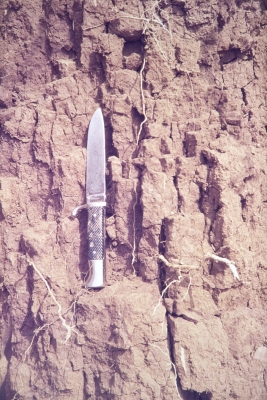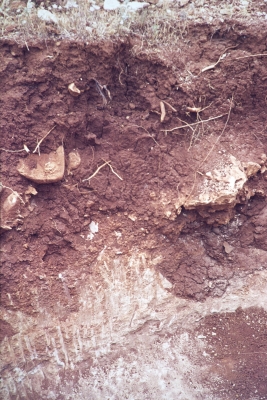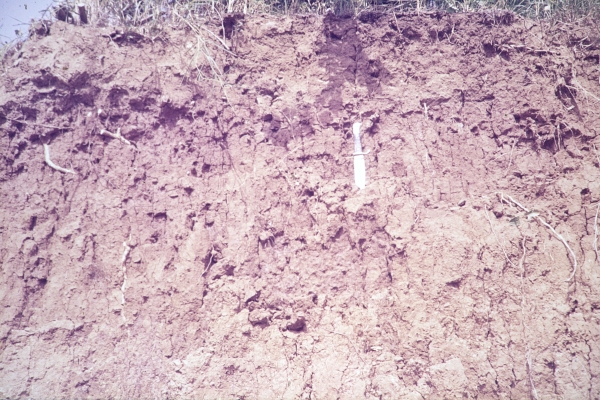Lurzoruaren
- Chromic Luvisols: 100%
- Teknikekin
| Aukera | Sakonera | Drainatze | Testura Erreakzio - pH-dun | Organikoa Carbon Eroankortasuna - Elektriko | Zorupearen katioia truke | Buztina katioia truke | Kaltzio karbonatoa - Karea | Gypsum Sodium - Trukatu |
|---|---|---|---|---|---|---|---|---|
| Topsoil | 3 | 6.4 | 0.86 | 12 | 38 | 0 | 0 | |
| Zorupearen | 3 | 6.4 | 0.38 | 15 | 40 | 0 | 0 |
Lurzoruaren Triangle - Chromic Luvisols
Irudiak - Chromic Luvisols




Definizioa - Chromic Luvisols
- Luvisols güclü kahverengi və ya qırmızı argic yeraltı üfüqdə bir (boztəhər) qəhvəyi üzərində qəhvəyi səthi üfüqdə tipik olaraq bir qəhvəyi var. Kromik 150 bir yeraltı lay torpaq səthinin sm, 30 sm və ya daha qalın bir Munsell hue redder daha 7,5 il və ya, həm də ki, 7.5 il bir renk və daha çox, nəm, Parlaq 4 daxilində olan göstərir. Xüsusilə subtropik Luvisols, bir kireçli üfüqdə bilər və ya yumşaq toz əhəng mobil və qırmızımtıl qəhvəyi argic üfüqdə aşağıda baş verir. Torpaq rənglər isti iqlim nisbətən sərin bölgələrdə Luvisols az qırmızı olur. Nəm mühitdə, səthinin torpaq dərəcədə gil və pulsuz dəmir oksidləri tükənəcək ola bilər ki, bir qaranlıq lakin nazik A-üfüqdə bir boztəhər eluviation üfüqdə formaları. Luvisols Aralıq dənizi və Cənubi Avstraliya da əsasən belə Rusiya Federasiyası, Amerika Birləşmiş Ştatları və Mərkəzi Avropanın qərb və mərkəz kimi mülayim rayonlarda, 500-600 milyon ha dünyada artıq uzatmaq, lakin. Subtropik və tropik regionlarda Luvisols əsasən gənc torpaq səthlərə baş verir. Ən Luvisols münbit torpaqları və kənd təsərrüfatı istifadəsi geniş uygundur. Bu mülayim zonasında Luvisols geniş kiçik taxıl, şəkər çuğunduru və yem üçün əkilir; maili ərazilərdə onlar meyvə bağları, meşələr və / və ya otlaq üçün istifadə olunur. Bu tez-tez eroziyaya yuxarı yamacında geniş istifadə olunur isə Luvisols (bu xromlu, kireçli və ya Vertic Qualifier çox) aşınma daşı, əhəng daşı colluvial yataqlarının ümumi olduğu Aralıq dənizi olaraq, aşağı yamacları geniş buğda və / və ya şəkər çuğunduru üçün əkin olunur otlaq və ya ağac bitkiləri üçün əkilmişdir
Deskribapena - Limosos
- Loams ən faydalı "bütün ətrafında" torpaqların və onlar bu gillər gücü və retentiveness ilə, qum və yüngüllük və earliness birləşdirir. Loams qum, 40 faiz 60-ehtiva və gil faizi 15-25. Onlar asan, qabığı və ya crack deyil, həm də əsasən vacibdir ki, bitki qida ilə təchiz, və yoxdur "qədər iş", onların vasitəsilə su hərəkət sərbəst və hələ onlar leachy deyil. Praktiki olaraq bütün təsərrüfat bitkiləri bir loam haqqında qənaətbəxş bitir. Bu, kartof, qarğıdalı, bazar bağçılıq bitkilər və kiçik meyvə, xüsusilə də uyğun deyil, lakin otlar, taxıl, yonca, yonca və pambıq, bu, uyğun tapa bilərsiniz. Yaxşı əkinçilik, drenaj və hər yerdə ən yaxşı təsərrüfatı təcrübə zəruri hissəsi kimi humus əlavə bu cür diqqət başqa heç bir xüsusi müalicə tələb edir. Onlar nisbətən quru mövsüm kimi biber halda, mülayim tropik və subtropik iqlim əkilir əgər etməz, yaxşı drains yaxşı loam bir wetter iqlim ofset kömək elə. Ən çox meyvə ağacları daha uzun yaşayır və onlar balanslaşdırılmış loam inkişaf zaman daha yaxşı verir. Sitrus ağacları yaxşı drenaj istəyirəm, lakin onlar nəmli saxlanılır lazımdır. Loam sitrus üçün yaxşı seçimdir
Metrikak/Eztabaida
| Gaia | Balioa | Xehetasunak |
|---|---|---|
| Drainatze | 3 | Atzealdea
Definizioa
|
| Lurzoruaren erreferentzia sakonera | 100 mm | ErronkaDefinizioa
|
| Base saturation | 89% | Erronka
Aholkuak
Atzealdea
Definizioa
|
| Kaltzio karbonatoa CaCO3 - Karea | 0% Pisua | AtzealdeaDefinizioa
|
| Karbono organikoaren | 0.86% Pisua | ErronkaAholkuak
Atzealdea
Definizioa
|
| Katioia underpressure - Buztina | 38 cmol/kg | Erronka
Aholkuak
Atzealdea
Definizioa
|
| Katioia underpressure - Lurzoruaren | 12 cmol/kg | Erronka
Aholkuak
Definizioa
|
| Buztina - Ehuneko - Pisua | 24% Pisua | Erronka
Aholkuak
AtzealdeaDefinizioa
|
| Hartxintxar - Ehuneko - Bolumena | 9% Pisua | ErronkaAholkuakDefinizioa |
| Harea - Ehuneko - Pisua | 47% Pisua | Erronka
Aholkuak
Atzealdea
Definizioa
|
| Silt - Ehuneko - Pisua | 29% Pisua | Erronka
AholkuakAtzealdea
Definizioa
|
| Eroankortasun elektrikoa | 0.1 dS/m | ErronkaAholkuakAtzealdea
Definizioa
|
| Igeltsua edukia CaSO4 | 0% Bolumena | Aholkuak
Atzealdea
Definizioa
|
| Soil reaction - pH-dun | 6.4 -log H+ | ErronkaAholkuak
Atzealdea
Definizioa
|
| Trukagarriak sodio | 1% | Definizioa
|
| Erreferentzia ontziratu dentsitatea | 1.54 kg/dm3 | Aholkuak
Atzealdea
Definizioa
|
| Nitrogeno (N) | ErronkaAholkuak
Atzealdea
| |
| Fosforoa (P) | Erronka
AholkuakAtzealdea
| |
| Potasio (K) | Aholkuak
Atzealdea
|
Zero Tillage
Conservation tillage systems such as zero tillage cause minimum disturbance to the soil after the previous crop has been harvested. In zero tillage, the ideal is to plant direct into the soil, without hoeing or plowing. Tillage is reduced to ripping planting lines or making holes for planting with a hoe. Crop residues are left in the field to reduce soil erosion, conserve moisture, inhibit weed growth, and act as green manure. Zero tillage is not recommended when disease is present. To manage disease, crop residues must be either removed from the field and destroyed or deeply ploughed to reduce sources of disease infection and spread.
Advantages of conservation tillage include less machinery, labour and fuel, as well as reduced soil erosion and compaction. Disadvantages of conservation tillage include lower soil temperatures, slower germination and emergence when direct sowing is used, slower early growth, delayed competition with weeds, higher incidence of root diseases, heavier crop residue, the possibility of more difficult planter operation, weed spectrum changes, and potential increase of soil insect pests or insects that spend part of their life cycle in the soil (e.g. cutworms, thrips, leafmining flies, grubs). Cultivation exposes these pests to desiccation by the sun heat and to predation by natural enemies.
Green Manuring
Green manure legumes create nitrogen in the soil by fixing it from the atmosphere.
Benefits of Green Manure Cover Crops
- Easy to grow
- Increases soil organic matter
- Reduce soil losses from wind and water erosion
- If it is a legume, it can fix nitrogen. When the legume is mature, chopped up and added to the soil, it will add nitrogen to the soil which will be used by later crops on the land.
- The roots of the green manure crops extract nutrients from deep in the soil.
- The deep roots work to break up and aerate the soil
- When the green manure is added to the soil, it works to lighten and loosen the soil to aerate and improve drainage, making the soil healthier for later crops. After tilling in a green manure crop, we see the soil level in the farm beds raise several inches. The soil is loose and no longer compacted.
- Green manure crops include jack beans, perennial peanut, and Mucuna.
- These plants help the main crop by increasing soil fertility by adding nitrogen to the soil by nitrogen fixation.
- They add biomass (organic matter) to the soil.
- As cover crops, they reduce soil loss.
Planting Green Manure Crops
Green manure crops can be planting using intercropping with the main crop or by using crop rotation in which the green manure crop is planted in-between plantings of the main crop. For intercropping, plant the legume seeds in rows between rows of the main crop. Plow the legumes into the soil at the start of the rainy season.
In crop rotation, plant legumes after the main crop has been harvested. The legumes will benefit the field as a cover crop and as green manure. At full biomass maturity, plow the legumes into the soil as green manure for the next crop.
For a source of green manure to the field, cut the legumes at full maturity, shred, and spread over the field.
Preventing Soil Erosion while Adding Nutrients to the Soil
The first step in soil management is preventing the loss, or erosion, of soil. Topsoil is particularly vulnerable to erosion if not protected by plants or mulch or by other measures. The soil that remains after the loss of topsoil is usually less productive, which can result in lower yields. The challenge is to protect soil while using the land for food production and other non-food activities.
Soil erosion is caused mainly by wind and water but also by incorrect cultivation practices. Rain and wind dislodge and then carry away soil particles. Where the soil is bare or the vegetation poor, rainwater does not seep into the soil; instead it runs off and carries with it loose topsoil. Sloping land and light soils with low organic matter content are both prone to erosion. Once eroded, the soil is lost forever.
Soil erosion is a problem in regions with little vegetation, particularly in the semi-arid and arid zones. In the humid tropics, erosion was not considered a problem when the land was in its natural state, because the variety of native plants kept the soils covered at all times. Now, people are clearing more land for agricultural purposes, and the situation has changed. Heavy rains coupled with poor soil management of cultivated areas are now common causes of soil erosion in the humid areas.
Water Erosion
Some common forms of water erosion include:
- Sheet erosion: a thin top layer of soil is removed from the soil by the impact of rain. With sheet erosion, small heaps of loose material (e.g. grass) amass between fine lines of sand after a rainstorm. This erosion takes place across a whole garden or field.
- Rill erosion: water flows over minor depressions on the land's surface and cuts small channels into the soil. The erosion takes place along the length of these channels.
- Gully erosion: a gully forms along natural depressions on the soil's surface or on slopes. The head of a gully moves up the slope in the opposite direction of the flow of water. Gullies are symptoms of severe erosion.
Wind Erosion
This occurs mostly on light soils and bare land. High winds cause severe damage. Wind erosion is a common problem in dry and semi-arid areas, as well as in areas that get seasonal rains.
Unlike water which only erodes on slopes, wind can remove soil from flat land as well as from sloping land; it can also transport the soil particles through the air and deposit them far away. Soils vulnerable to wind erosion are dry, loose, light soils with little or no vegetative cover.
Plowing up and down a slope causes soil erosion. To prevent the loss of soils, certain measures must be taken.
These include:
- clearing only the land to be cultivated;
- planting along a contour and using grassed channels;
- establishing windbreaks and bench terraces;
- plowing along a contour;
- planting cover crops and mulching.
When clearing land for cultivation, the beneficial effects of certain trees and plants should be considered. Some trees should be left, since they may supply food, medicine, shade or, when they shed their leaves, organic matter.
Feeding the Soil
One of the main goals in growing crops is to make the soil fertile and well structured, so a wide range of useful crops can grow and produce well. In order to grow, plants require nutrients that are present in organic matter, such as nitrogen, calcium and phosphorus, as well as minerals and trace elements.
If the natural fertility or structure of the soil is poor, it must be continuously "fed" with organic matter, such as leaves and manure, in order to improve its productivity and water-holding capacity. As organic matter decomposes, it becomes food for plants. It also improves soil structure by loosening heavy clay and binding sandy soil.
Feeding the soil with organic matter is especially important in the early years of cultivating the land. Organic matter (i.e. waste from plants and livestock) can be collected and buried in the soil, where it will decompose. The organic matter also can be used to make compost, which can be applied to the soil to enrich its fertility.
The roots of legumes contain nitrogen-fixing bacteria. Therefore, intercropping or rotating legumes with other crops helps maintain or improve the nitrogen content of the soil, and this enhances the growth of other plants.
Healthy plants yield more and are better protected from insects and disease. The application of organic matter, such as compost, animal manure, green manure and soil from anthills, improves soil structure and adds nutrients to the soil.
Long-Term Soil Management
The ideal way to protect and feed the soil is to apply organic matter or compost regularly and to keep the soil covered with plants. A multilayer cropping system in which a mixture of trees and other plants with different maturity times are grown together will protect the soil and recycle nutrients. Leguminous plants such as cowpeas, groundnuts and beans are particularly useful in providing continuous nutrients for crops.
Apply Organic Matter to Soil to Improve the Crop
Plants can contain up to 90 percent water. The water is absorbed mainly through the root system of the plant. With the water, plant nutrients are absorbed. Healthy roots need air (aeration) for development. Excess water in the soil prevents air from penetrating and damages a plant's roots. Water management is therefore extremely important in regions with good water resources as well as in those where water is scarce.
The water-holding capacity of soil varies according to soil type. Soil with a high content of organic matter has better aeration, better structure and better water-holding capacity. Heavy, sticky soils are too dense to allow air in and water out, so roots cannot breathe and plants can have growth problems. When this kind of soil dries out, it sets like cement, and water takes a long time to soak into it. On the other hand, sandy, coarse-grained soils are too loose to hold water before it drains away. In this kind of soil, without a regular external water supply, a plant's roots cannot find enough water for growth. Regular application of organic matter will improve the ability of both these kinds of soil to hold and release enough water and air. During land preparation for planting, organic materials such as animal manure or compost should be applied to the land such that they are well incorporated into the soil.
Iturriak
2. eHow (http://www.ehow.com/list_7256066_loam-soil-plants.html)
3. World reference base for soil resources 2006. 2nd edition. World Soil Resources Reports No. 103. FAO, Rome, page 86 (http://www.fao.org/ag/agl/agll/wrb/doc/wrb2006final.pdf)
4. Lecture Notes on the Major Soils of the World, FAO, Rome, 2001, page 265 (http://www.itc.nl/~rossiter/Docs/WRB/wsrr94e.pdf).
5. CT ECO (http://www.cteco.uconn.edu/guides/Soils_Drainage.htm)
6. McDonald, A.J., Cornell University, "Soil Drainage Classification and Hydric Soil Indicators" (http://www.css.cornell.edu/courses/260/Lab%20Hydric%20Soils.pdf), last modified on August 8, 2002.
7. FAO/IIASA/ISRIC/ISS-CAS/JRC, 2009. Harmonized World Soil Database (version 1.1). FAO, Rome, Italy and IIASA, Laxenburg, Austria (http://www.iiasa.ac.at/Research/LUC/External-World-soil-database/HWSD_Documentation.pdf)
8. FAO (http://www.fao.org/nr/land/soils/harmonized-world-soil-database/soil-quality-for-crop-production/en/).
9. FAO (http://www.fao.org/nr/land/soils/harmonized-world-soil-database/soil-quality-for-crop-production/en/)
10. FAO, AGL ProSoil (http://www.fao.org/ag/AGL/agll/prosoil/calc.htm)
11. Andre Bationo, Job Kihara, Bernard Vanlauwe, Boaz Waswa, Joseph Kimetu, "Soil organic carbon dynamics, functions and management in West African agro-ecosystems", Received 8 February 2005
12. accepted 18 August 2005 (http://www.zef.de/module/register/media/18ea_sdarticle.pdf)
13. Amacher, Michael C.
14. O’Neil, Katherine P.
15. Perry, Charles H. 2007. Soil vital signs: A new Soil Quality Index (SQI) for assessing forest soil health. Res. Pap. RMRS-RP-65WWW. Fort Collins, CO: U.S. Department of Agriculture, Forest Service, Rocky Mountain Research Station. 12 p. (http://www.fs.fed.us/rm/pubs/rmrs_rp065.pdf)
16. Grameen Foundation (www.grameenfoundation.org)
17. Mississippi State University (http://msucares.com/lawn/garden/vegetables/soil/index.html)
18. World reference base for soil resources 2006. 2nd edition. World Soil Resources Reports No. 103. FAO, Rome (http://www.fao.org/ag/agl/agll/wrb/doc/wrb2006final.pdf)
19. How to Improve Soils (http://www.howtoimprovesoils.info/kinds-of-soils/clay-soils-clay-loams-loam-soils.html)
20. University of Arizona (http://ag.arizona.edu/pubs/garden/mg/soils/principal.html)
21. BBC (http://www.bbc.co.uk/gardening/htbg/module1/soil_types1.shtml)
22. University of Florida (http://edis.ifas.ufl.edu/tr004)
23. Which? (http://www.which.co.uk/documents/pdf/growing-on-gravel-154029.pdf)
24. eHow.com (http://www.ehow.com/how_7626870_garden-gravelly-soil.html)
25. FAO/IIASA/ISRIC/ISS-CAS/JRC, 2009. Harmonized World Soil Database (version 1.1). FAO, Rome, Italy and IIASA, Laxenburg, Austria (http://www.iiasa.ac.at/Research/LUC/External-World-soil-database/HWSD_Documentation.pdf).
26. University of Florida (http://edis.ifas.ufl.edu/ss169)
27. PROSEA: Plant Resources of South–East Asia (www.proseanet.org)
28. PROTA: Plant Resources of Tropical Africa (http://www.prota.org/)
29. EcoPort Programme, FAO (http://ecoport.org/)
30. Lecture Notes on the Major Soils of the World, FAO, Rome, 2001 (http://www.itc.nl/~rossiter/Docs/WRB/wsrr94e.pdf).
31. eHow.com (http://www.ehow.com/list_7464662_list-grow-different-soil-types.html#ixzz1YRUWbhI5)
32. Discovery Education (http://school.discoveryeducation.com/schooladventures/soil/name_soil.html)
33. Wikipedia.org, "Soil Salinity Control" (http://en.wikipedia.org/wiki/Soil_salinity_control), last modified on January 19, 2012.
34. FAO, "Management of Gypsiferous Soils" (http://www.fao.org/docrep/t0323e/t0323e00.htm#Contents)
35. Wikipedia.org, "Soil pH" (http://en.wikipedia.org/wiki/Soil_pH)
36. PlanTea (http://www.plantea.com/pH.htm)
37. Wikipedia.org, "Tropical Agriculture" (http://en.wikipedia.org/wiki/Tropical_agriculture#Acidic_soils)
38. Wikipedia.org, "Alkali soils" (http://en.wikipedia.org/wiki/Alkali_soils)
39. Spectrum Analytic (http://www.spectrumanalytic.com/support/library/ff/CEC_BpH_and_percent_sat.htm)
40. Pennsylvania State University (http://pubs.cas.psu.edu/FreePubs/pdfs/uc038.pdf)
41. Clemson University (hubcap.clemson.edu/~blpprt/IL64.html)
42. Soil Quality for Environmental Health (http://soilquality.org/indicators/bulk_density.html).
43. Soil Quality for Environmental Health (http://soilquality.org/indicators/bulk_density.html)
44. USDA (http://soils.usda.gov/sqi/publications/files/sq_two_1.pdf).
45. Rhoades, Heather, "Adding Nitrogen As A Plant Fertilizer," Gardening Know How (http://www.gardeningknowhow.com/gardening-how-to/nitrogen-plant-fertilizer.htm)
46. Perry, Charles H. 2007. Soil vital signs: A new Soil Quality Index (SQI) for assessing forest soil health. Res. Pap. RMRS-RP-65WWW. Fort Collins, CO: U.S. Department of Agriculture, Forest Service, Rocky Mountain Research Station. 12 p. (http://www.fs.fed.us/rm/pubs/rmrs_rp065.pdf).
47. Rhoades, Heather, "The Importance Of Phosphorus In Plant Growth," Gardening Know How (http://www.gardeningknowhow.com/gardening-how-to/phosphorus-plant-growth.htm)
48. Rhoades, Heather, "Plants And Potassium: Using Potassium And Potassium Deficiency In Plants," Gardening Know How (http://www.gardeningknowhow.com/gardening-how-to/plants-potassium.htm)